Comments / Questions (25)
![]() Zaza wrote:
Zaza wrote:
Bonjour Merci d'avoir répondu si vite . Bonne journée Cordialement . zaza
29.01.2024 - 13:47
![]() Zaza wrote:
Zaza wrote:
Une derniere question ; quand vous dite ; 2ème PARTIE: Tricoter en suivant le même principe que pour la 1ère partie, mais tricoter les diagrammes et les rangs raccourcis d'une autre façon. qu'entendez vous d'une autre façon ?? cordialement
28.01.2024 - 22:07DROPS Design answered:
La façon de tricoter les diagrammes sont décrits dans le paragraphe suivant sous LIRE ATTENTIVEMENT LA SECTION SUIVANTE AVANT DE CONTINUER!, on tricote les rangs raccourcis d'abord en laissant 7 mailles (24 fois au total) puis on laissera 6 mailles (8 fois). Bon tricot!
29.01.2024 - 12:52
![]() Zaza wrote:
Zaza wrote:
Bonsoir, je suis a faire la 2ème fois de A3 et A4. Vous dite ceci :Continuer de la même façon, en rangs raccourcis, en tricotant 6 mailles en moins à chaque fois, jusqu'à ce que les diagrammes aient été tricotés 2.5 fois au total en hauteur (voir la flèche pour savoir où arrêter le diagramme). On a 216 mailles et on a tricoté 40 rangs du point ajouré. Est ce que les 6 mailles en moins jusqu'à la fin car dans la premiere partie c'etais 6 mailles et ensuite 7 mailles Cordialement
28.01.2024 - 22:02DROPS Design answered:
Bonjour Zaza, on tricote les rangs raccourcis en laissant toujours 6 mailles avant de tourner, comme au 1er rang sur l'endroit, Sur l'envers on tricote jusqu'à ce qu'il reste 7mailles et on tricote A.1 au-dessus de ces 7 mailles = on tricote les mailles jusqu'à la fin du rang; autrement dit, on tricote toujours 6 m en moins à la fin de chaque rang sur l'endroit. Bon tricot!
29.01.2024 - 12:51
![]() Zaza wrote:
Zaza wrote:
Bonjour, je viens de commencer ce chale et je suis arrivée a tricoter A1 et A2 (201 mailles ) Après avoir tricoté et défait plusieurs fois les 8 premiers rangs de A3 et A4, je pense que les rangs 5 et 13 ne doivent avoir qu un seul jeté tricoté torsé a l'envers au lieu de 2 comme indiqué sur le diagramme (quand on tricotera les rangs 6 et 14. Qu 'en pensez vous ? Cordialement
28.01.2024 - 17:41
![]() Vibe Acacia Snebjørk Toft wrote:
Vibe Acacia Snebjørk Toft wrote:
Sjal " Morning Ray" Model bs- 155 1. DEL: Diagram A1 A2 fortsættes 3 gange i højden. Skal de forkortede pinde fortsætte (ved 24. Pind og 48. Pind), eller starter du forfra hvergang du starter diagramet på ny? Det er lidt svært at se på billedet? Mvh Acacia Og tak
13.10.2022 - 08:59DROPS Design answered:
Hej, vi forstår ikke dit spørgsmål. Skriv hvor du er i opskriften og hvilket stykke du ikke forstår, så skal vi prøve at svare :)
25.10.2022 - 10:57
![]() Elisa wrote:
Elisa wrote:
Buonasera io ho un dubbio per quanto riguarda le parti 3 e 4.Per quanto riguarda la parte 3 viene indicato di ripetere i diagrammi A1 e A2 per 5 volte (per un totale di 40 ferri)ma vengono date indicazioni sui ferri accorciati solo per 32 ferri.La mia domanda è nell'ultima ripetizione dei diagrammi come devo comportarmi?Lo stesso vale per la parte 4 dove i ferri da lavorare sono 64 e vengono date indicazioni sempre per 32!Grazie mille Elisa
03.09.2022 - 18:12DROPS Design answered:
Buonasera Elisa, per i ferri accorciati deve proseguire come indicato in precedenza. Buon lavoro!
27.09.2022 - 22:46
![]() Katja wrote:
Katja wrote:
Finns det fel i första delen? Har stickat första delen två gånger om, och maskantalet stämmer inte. Om man kontinuerligt vänder 6 maskor tidigare än förra varvet så blir man till slut med 163, maskor, inte 216.
24.09.2021 - 16:10DROPS Design answered:
Hej Katje, fortsætter du med at tage ud ifølge diagrammerne?
06.10.2021 - 14:11
![]() Isabel Sarle wrote:
Isabel Sarle wrote:
There is a message saying there is a correction on Section 2,3 and 4 but not what the corrections is. I am confused at the two knit rows between the sections.
23.07.2021 - 23:08DROPS Design answered:
Dear Isabel, the corrections are written imto the pattern, as it was rephrased to make it easier to understands. The two knit rows are just that, two rows, knitted on all the stitches, but in the first row, when you get to the points where you turned earler, thighten the strand to make the hole made by the turn less noticeable. Happy Stitching!
24.07.2021 - 09:38
![]() Barbara wrote:
Barbara wrote:
Guten Tag, ich bin am Anfang des Tuches, Teil 1. Ich habe eine Frage zu Diagramm A1 und A2: Werden die Zunahmen (A2) jeweils zu Beginn der Hinreihen gestrickt? Die verkürzten Reihen befinden sich am Ende der Hinreihe? Ich bin nicht sicher, ob ich das richtig verstanden habe. Falls ja, würde A2 somit in der Hinreihe den Beginn der Reihe zeigen. Herzlichen Dank für Ihre Antwort :-)
26.05.2021 - 18:46DROPS Design answered:
Liebe Barbara, die Zunahmen werden in A.1 gestrickt, bei A.2 wird es nicht abgenommen - die verkürzten Reihen werden bei den Hinreihen gestrickt: bei der 1. Reihe (= Hinreihe) stricken Sie bis 6 Maschen übrig sind (verkürzte Reihe), wenden, die Rückreihe stricke, dann 3. Reihe = 2. Hinreihe in A.1/A.2 stricken und dann 6 Maschen weniger stricken (= die letzte 6 Maschen nicht stricken = es sind jetzt 12 M am Ende den Hinreihen, die nicht gearbeitet wurden ), usw. Viel Spaß beim stricken!
27.05.2021 - 09:22
![]() Amélie wrote:
Amélie wrote:
Je vous remercie pour votre réponse. J'ai, à présent, un problème pour comprendre les instructions pour les rangs raccourcis en coloris naturel de la seconde partie. Le patron indique de tourner l'ouvrage 7 mailles plus tôt "à chaque fois" et 24 fois au total. Cela signifie-t-il qu'il faut faire des rangs raccourcis à l'endroit ET à l'envers ? J'avoue que spontanément je n'en aurais fait que sur les rangs envers ...
16.04.2021 - 22:53DROPS Design answered:
... Juste encore une petite précision, les rangs raccourcis se font toujours du même côté: tricotez jusqu'à ce qu'il reste x mailles, tournez et tricotez le rang suivant, tricotez jusqu'à ce qu'il reste x + 7 (puis 6) m, tournez et tricotez le rang suivant et ainsi de suite. Bonne continuation!
19.04.2021 - 07:50
Morning Rays#morningraysshawl |
||||||||||||||||||||||
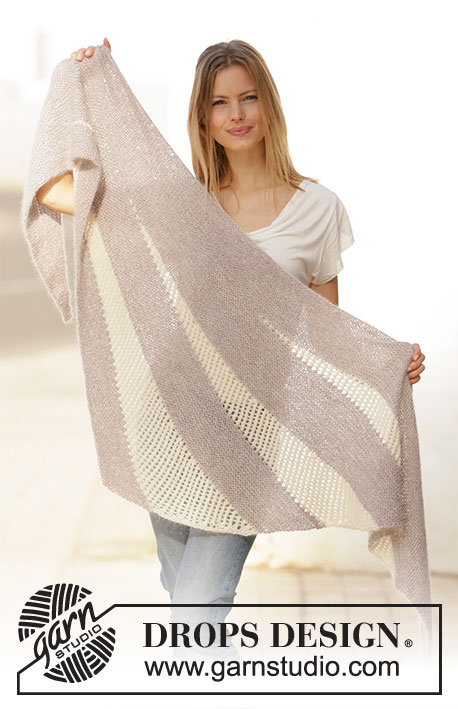 |
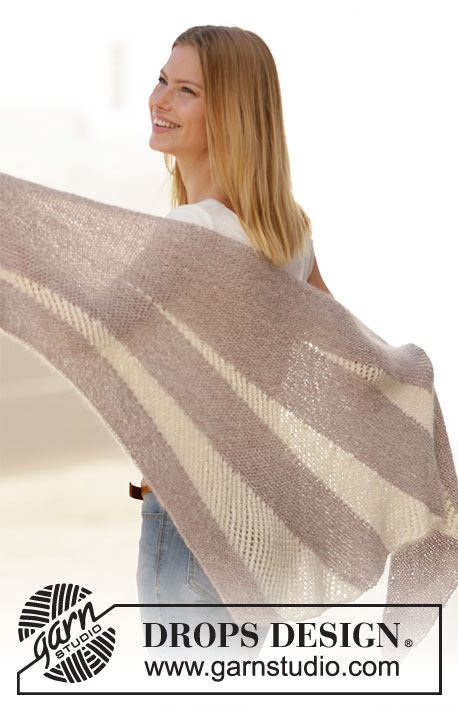 |
|||||||||||||||||||||
Knitted shawl with garter stitch and lace pattern in DROPS BabyAlpaca Silk and DROPS Kid-Silk. Work piece back and forth with short rows.
DROPS 210-38 |
||||||||||||||||||||||
|
---------------------------------------------------------- EXPLANATION FOR THE PATTERN: ---------------------------------------------------------- GARTER STITCH (back and forth): Knit all rows. 1 ridge vertically = knit 2 rows. PATTERN: See diagrams A.1 to A.4. Diagrams show all rows in pattern seen from the right side. ---------------------------------------------------------- START THE PIECE HERE: ---------------------------------------------------------- SHAWL - SHORT OVERVIEW OF THE PIECE: Work piece back and forth on circular needle. Work according to diagrams to increase in one side of piece, AT THE SAME TIME work short rows. SHAWL: Cast on 192 stitches on circular needle size 5.5 mm with 1 strand off white Kid-Silk and 1 strand light grey purple BabyAlpaca Silk. Knit 1 row (= wrong side). Then work 4 parts with short rows as follows: PART 1: Work according to diagrams A.1 and A.2 as follows: From right side: Work diagram A.1 over 6 stitches, work according to diagram A.2 until 6 stitches remain on needle. Tighten yarn and turn piece. From wrong side: Work diagram A.2 until 7 stitches remain, work A.1 over 7 stitches (remember to work the black yarn over from previous row twisted to avoid holes). Turn piece. Continue to work diagrams like this but on every row from right side, turn piece 6 stitches earlier than last time. When the diagrams have been worked 1 time vertically, 3 stitches have been increased and there are 4 ridges in total (in addition to cast-on edge) = 195 stitches. Continue to work diagrams with short rows until diagrams have been worked 3 times vertically. There are 201 stitches on row, and 12 ridges have been worked (in addition to cast-on edge). Switch to off white Kid-Silk and off white BabyAlpaca Silk. Work according to diagrams A.3 and A.4 as follows: From right side: Work diagram A.3 over 6 stitches, work A.4 until 6 stitches earlier than on previous turn. Turn piece. From wrong side: Work diagram A.4 until 7 stitches remain, work A.3 over 7 stitches (remember that the black yarn over in diagram is purled twisted to avoid holes). Continue to work like this until diagrams have been worked 1 time vertically. 6 stitches have been increased, and there are 8 eyelet rows in total = 207 stitches. Continue the same way by working short rows over 6 stitches less every time until diagrams have been worked 2.5 times vertically (see arrow in diagram that shows where diagram should end in the middle of a repetition). 216 stitches on row and 40 rows have been worked with lace pattern. Switch to 1 strand Kid-Silk in off white and 1 strand BabyAlpaca Silk in light grey purple. Knit 1 row over all stitches on row, make sure to tighten where piece is turned, so avoid large holes. Turn and knit 1 row from wrong side. PART 2: Work after same principle as 1st part, but work diagrams and short rows in a different way. READ ALL OF THE FOLLOWING SECTION BEFORE CONTINUING! Diagrams A.1 and A.2 are worked 4 times vertically with Kid-Silk in off white and BabyAlpaca Silk in light grey purple, then work diagram A.3 and A.4 with Kid-Silk in off white and BabyAlpaca Silk in off white 2 times vertically - AT THE SAME TIME turn piece first time when 7 stitches remain on needle, continue to turn 7 stitches earlier each time a total of 24 times (including the first turn), then turn 6 stitches earlier a total of 8 times. There are 240 stitches on needle. Switch to 1 strand Kid-Silk in off white and 1 strand BabyAlpaca Silk in light grey purple. Now work over all stitches on needle as follows: Work over all stitches on row, make sure to tighten where piece is turned, so avoid large holes. Turn and knit 1 row from wrong side. PART 3: Work after same principle as 1st and 2nd part, but work according to diagrams and short rows in a different way. READ ALL OF THE FOLLOWING SECTION BEFORE CONTINUING! Diagrams A.1 and A.2 are worked 5 times vertically with Kid-Silk in off white and BabyAlpaca Silk in light grey purple, then work diagrams A.3 and A.4 with Kid-Silk in off white and BabyAlpaca Silk in off white 1.5 times vertically (see arrow in diagram to show where diagram ends in the middle of a repetition) - AT THE SAME TIME turn piece first time when 8 stitches remain on needle, continue to turn 8 stitches earlier each time a total of 16 times (including the first turn), then turn 7 stitches earlier a total of 16 times. There are 264 stitches on needle. Switch to 1 strand Kid-Silk in off white and 1 strand BabyAlpaca Silk in light grey purple. Now work over all stitches on needle as follows: Work over all stitches on row, make sure to tighten where piece is turned so avoid large holes. Turn and knit 1 row from wrong side. PART 4: Work after same principle as 1st, 2nd and 3rd part, but work diagrams and short rows in a different way. READ ALL OF THE FOLLOWING SECTION BEFORE CONTINUING! Diagrams A.1 and A.2 are worked 8 times vertically with Kid-Silk in off white and BabyAlpaca Silk in light grey purple, - AT THE SAME TIME turn piece first time when 9 stitches remain on needle, continue to turn 9 stitches earlier each time a total of 8 times (including the first turn), then turn 8 stitches earlier a total of 24 times. There are 288 stitches on needle. Now work over all stitches on needle as follows: Work over all stitches on row, make sure to tighten where piece is turned, so avoid large holes. Turn and knit 1 row from wrong side. Loosely cast off by knitting on next row from right side. |
||||||||||||||||||||||
Diagram explanations |
||||||||||||||||||||||
|
||||||||||||||||||||||
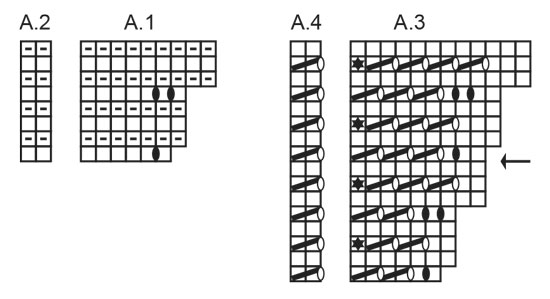 |
||||||||||||||||||||||
Have you finished this pattern?Tag your pictures with #dropspattern #morningraysshawl or submit them to the #dropsfan gallery. Do you need help with this pattern?You'll find 10 tutorial videos, a Comments/Questions area and more by visiting the pattern on garnstudio.com. © 1982-2025 DROPS Design A/S. We reserve all rights. This document, including all its sub-sections, has copyrights. Read more about what you can do with our patterns at the bottom of each pattern on our site. |
||||||||||||||||||||||







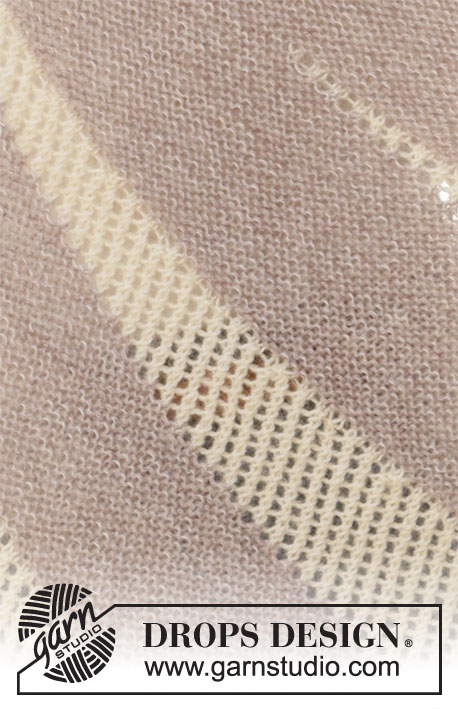
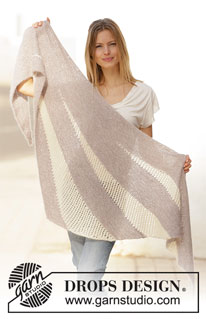
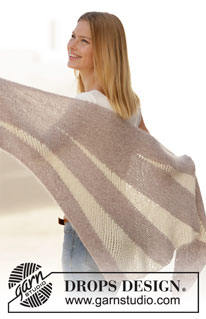
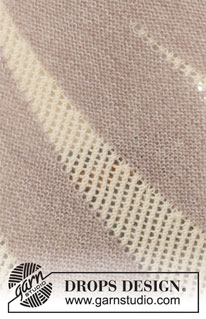





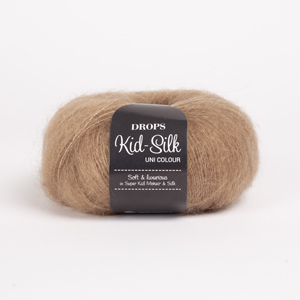





































Post a comment to pattern DROPS 210-38
We would love to hear what you have to say about this pattern!
If you want to leave a question, please make sure you select the correct category in the form below, to speed up the answering process. Required fields are marked *.